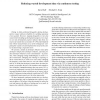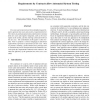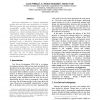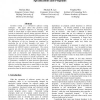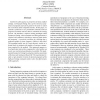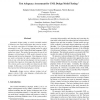109
Voted
ISSRE
2003
IEEE
15 years 6 months ago
2003
IEEE
Testing is often performed frequently during development to ensure software reliability by catching regression errors quickly. However, stopping frequently to test also wastes tim...
96
Voted
ISSRE
2003
IEEE
15 years 6 months ago
2003
IEEE
Use-cases and scenarios have been identified as good inputs to generate test cases and oracles at requirement level. Yet to have an automated generation, information is missing f...
106
click to vote
ISSRE
2003
IEEE
15 years 6 months ago
2003
IEEE
Test-driven development is a software development practice that has been used sporadically for decades. With this practice, test cases (preferably automated) are incrementally wri...
102
Voted
ISSRE
2003
IEEE
15 years 6 months ago
2003
IEEE
Partition testing is a well-known software testing technique. This paper shows that partition testing strategies are relatively ineffective in detecting faults related to small sh...
97
Voted
ISSRE
2003
IEEE
15 years 6 months ago
2003
IEEE
This paper presents DARX, our framework for building applications that provide adaptive fault tolerance. It relies on the fact that multi-agent platforms constitute a very strong ...
ISSRE
2003
IEEE
15 years 6 months ago
2003
IEEE
Symmetries often appear as properties of many artifical settings. In Program Testing, they can be viewed as properties of programs and can be given by the tester to check the cor...
115
click to vote
ISSRE
2003
IEEE
15 years 6 months ago
2003
IEEE
Many architecture–based software reliability models were proposed in the past. Regardless of the accuracy of these models, if a considerable uncertainty exists in the estimates ...
105
Voted
ISSRE
2003
IEEE
15 years 6 months ago
2003
IEEE
Systematic design testing, in which executable models of behaviors are tested using inputs that exercise scenarios, can help reveal flaws in designs before they are implemented i...
114
Voted
ISSRE
2003
IEEE
15 years 6 months ago
2003
IEEE
-- This paper presents three principles for alarm analysis to develop early warnings of failure. The concepts are illustrated with real data and experience drawn from Comverse Voic...
136
Voted
ISSRE
2003
IEEE
15 years 6 months ago
2003
IEEE
Component based software development is prone to unexpected interaction faults. The goal is to test as many potential interactions as is feasible within time and budget constraint...
